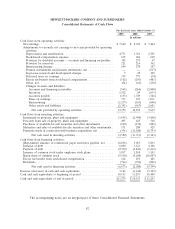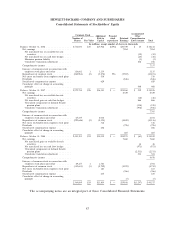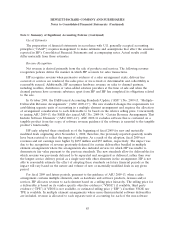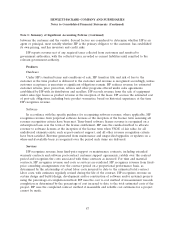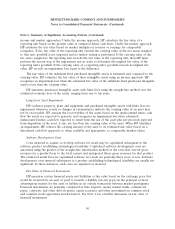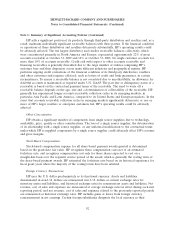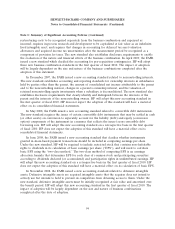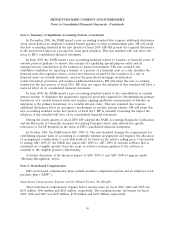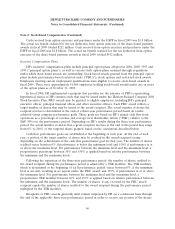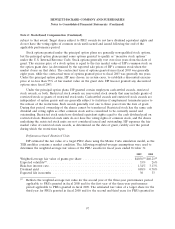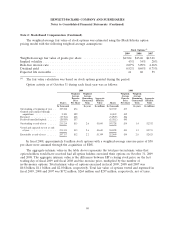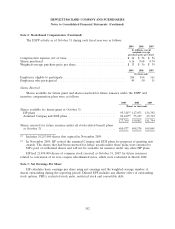HP 2009 Annual Report Download - page 99
Download and view the complete annual report
Please find page 99 of the 2009 HP annual report below. You can navigate through the pages in the report by either clicking on the pages listed below, or by using the keyword search tool below to find specific information within the annual report.HEWLETT-PACKARD COMPANY AND SUBSIDIARIES
Notes to Consolidated Financial Statements (Continued)
Note 1: Summary of Significant Accounting Policies (Continued)
HP sells a significant portion of its products through third-party distributors and resellers and, as a
result, maintains individually significant receivable balances with these parties. If the financial condition
or operations of these distributors and resellers deteriorate substantially, HP’s operating results could
be adversely affected. The ten largest distributor and reseller receivable balances collectively, which
were concentrated primarily in North America and Europe, represented approximately 22% of gross
accounts receivable at October 31, 2009 and 18% at October 31, 2008. No single customer accounts for
more than 10% of accounts receivable. Credit risk with respect to other accounts receivable and
financing receivables is generally diversified due to the large number of entities comprising HP’s
customer base and their dispersion across many different industries and geographical regions. HP
performs ongoing credit evaluations of the financial condition of its third-party distributors, resellers
and other customers and requires collateral, such as letters of credit and bank guarantees, in certain
circumstances. To ensure a receivable balance is not overstated due to uncollectibility, an allowance for
doubtful accounts is maintained as required under U.S. GAAP. The past due or delinquency status of a
receivable is based on the contractual payment terms of the receivable. The need to write off a
receivable balance depends on the age, size and a determination of collectability of the receivable. HP
generally has experienced longer accounts receivable collection cycles in its emerging markets, in
particular Asia Pacific and Latin America, compared to its United States and European markets. In the
event that accounts receivable collection cycles in emerging markets significantly deteriorate or one or
more of HP’s larger resellers or enterprise customers fail, HP’s operating results could be adversely
affected.
Other Concentration
HP obtains a significant number of components from single source suppliers due to technology,
availability, price, quality or other considerations. The loss of a single source supplier, the deterioration
of its relationship with a single source supplier, or any unilateral modification to the contractual terms
under which HP is supplied components by a single source supplier could adversely affect HP’s revenue
and gross margins.
Stock-Based Compensation
Stock-based compensation expense for all share-based payment awards granted is determined
based on the grant-date fair value. HP recognizes these compensation costs net of an estimated
forfeiture rate, and recognizes compensation cost only for those shares expected to vest on a
straight-line basis over the requisite service period of the award, which is generally the vesting term of
the share-based payment awards. HP estimated the forfeiture rate based on its historical experience for
fiscal grant years where the majority of the vesting terms have been satisfied.
Foreign Currency Transactions
HP uses the U.S. dollar predominately as its functional currency. Assets and liabilities
denominated in non-U.S. dollars are remeasured into U.S. dollars at current exchange rates for
monetary assets and liabilities, and historical exchange rates for nonmonetary assets and liabilities. Net
revenue, cost of sales and expenses are remeasured at average exchange rates in effect during each new
reporting period, and net revenue, cost of sales and expenses related to the previously reported periods
are remeasured at historical exchange rates. HP includes gains or losses from foreign currency
remeasurement in net earnings. Certain foreign subsidiaries designate the local currency as their
92


